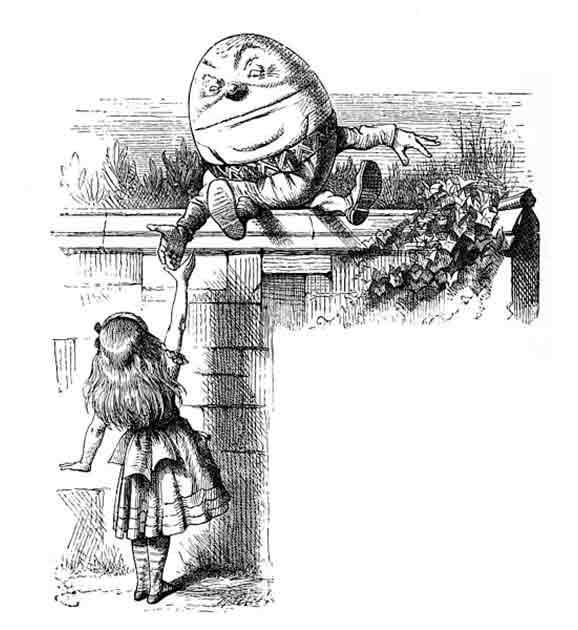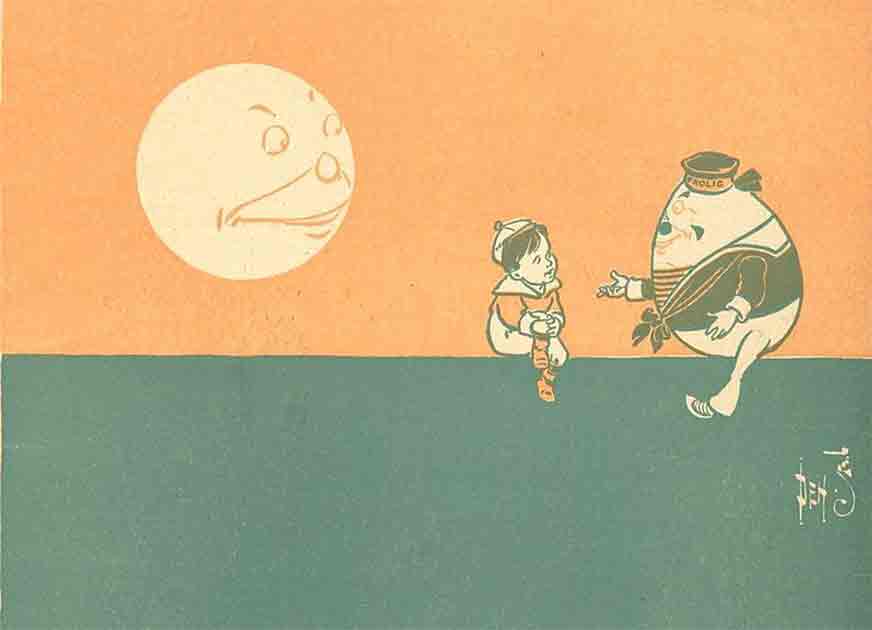Humpty Dumpty sat on a wall. Humpty Dumpty had a great fall. All the King’s horses and all the King’s men couldn’t put Humpty together again.
It’s a rough break for a giant egg, and as with many nursery rhymes we accept the little story and move on with our lives without thinking too much about it. But, as with most nursery rhymes, there is a lor more going on beneath the surface.
If nothing else we should be intrigued by the strangeness of the story. Why is Humpty Dumpty considered to be a giant, living egg? It doesn’t say so anywhere in the rhyme.
Why is he associated with the King, and why does the King try to repair him? And that’s without even getting started on the involvement of the King’s horses.
The enigmatic figure of Humpty Dumpty, immortalized in the nursery rhyme that has been recited through generations, seems weirder the more you think about it. And there is good reason for that, as once you start to pick apart the story of Humpty Dumpty you will realize it was originally very different.
The Origins of Humpty Dumpty
The Humpty Dumpty nursery rhyme, as known today, involves a character named Humpty Dumpty who falls off a wall and cannot be restored to his former state, despite the efforts of “all the King’s horses and all the King’s men.” The simplicity of the rhyme belies its complex history and the layers of meaning that have been attributed to it over the centuries.

As noted, the original verses never explicitly describe Humpty Dumpty as an egg, a portrayal that would later be popularized by Lewis Carroll’s “Alice Through the Looking-Glass” (1872). The earliest recorded versions of the rhyme date back to the late 18th century, but its origins likely go much centuries earlier, morphing and evolving through oral tradition before being crystallized in print.
- Origin of London Bridge is Falling Down
- Queen Mab and Dreams: Shakespeare’s Inspiration or Another’s?
One of the most compelling theories about Humpty Dumpty’s origins suggests that it was not a person or an anthropomorphic egg but, rather, a large siege cannon used during the English Civil War (1642–1651). According to this theory, the cannon was mounted on the walls of Colchester, a town under siege in 1648, and the King here is Charles I.
When the wall was damaged, the cannon tumbled down, and the King’s men (the Royalist forces) were unable to lift it back into position, leading to the town’s fall to the Parliamentarians. This story, while not definitively proven, is supported by some historical accounts and adds a layer of martial significance to the nursery rhyme, transforming Humpty Dumpty from a children’s character into a symbol of war and loss.
It certainly makes more sense than a giant egg, anyway. A giant cannon mounted on the city walls would be both a potent defender of the city, and an obvious target the attacker would want to have “a great fall”. Even the horses, used in vain to recover the cannon from where it had fallen, make sense in this context.
The transformation of Humpty Dumpty into an egg is largely attributed to Lewis Carroll, whose depiction in “Alice Through the Looking-Glass” firmly entrenched the character’s egg-like appearance in the public’s imagination. Carroll’s whimsical and imaginative literature knowingly played with and reinterpreted existing narratives, and his illustration of Humpty Dumpty as an egg with a face, arms, and legs, conversing with Alice, has become the definitive image for generations of readers.
This reimagining may have been influenced by earlier symbolic uses of eggs in folklore and literature to represent fragility and the potential for fall and breakage, fitting themes for the original rhyme’s narrative. But the idea of Humpty Dumpty as an egg is definitely a later invention, not a part of the original rhyme.
So a Cannon, Then?
While the siege cannon theory is compelling (and neatly fits the rhyme), it is not the only theory about who or what Humpty Dumpty was. Some historians and folklorists suggest that Humpty Dumpty could have been a reference to King Richard III of England, described as “humpbacked” and who suffered a catastrophic fall from power at the Battle of Bosworth Field.
This seems less certain, as the rest of the rhyme is a poor match for the story of Richard III. Supporters of this theory struggle to understand the relevance of the “wall” and the best gloss for “all the King’s horses and all the King’s men” is a weak attribution to Richard’s loss and death at Bosworth despite his grand army.
Others still interpret the rhyme as a riddle, with the answer being “egg,” a theory that predates Carroll’s interpretation but lacks solid historical evidence. This runs into similar problems to the above interpretation, although there are some neat parallels, such as toast sliced into rectangles for dipping into a soft-boiled egg being referred to as “soldiers”.
- Brownies of Scotland: The Mischievous Household Spirits
- Sir Marrok: The Werewolf at the Court of King Arthur
Further theories posit Humpty Dumpty as a symbol of the downfall of the powerful, a cautionary tale about pride and hubris leading to inevitable fall. This interpretation allows the rhyme to be seen as a political satire, reflecting the instability and unpredictability of royal and political power.

Ultimately he true origins and identity of Humpty Dumpty may never be fully unraveled. The transition from a possibly historical or allegorical figure to a fictional egg character underscores the fluidity of folklore and the way stories evolve over time to fit the cultural and societal context in which they are retold.
Lewis Carroll’s contribution to the Humpty Dumpty story exemplifies how literature can redefine and immortalize folklore, embedding it in the collective consciousness in new and unexpected forms. He may have embellished the story and, in doing so, took it further away from its origins, but he enriched it at the same time.
Humpty Dumpty’s origins, whether as a siege cannon, a fallen king, or a cautionary tale of hubris, speaks to the human desire to seek meanings and stories behind the seemingly simple and innocuous. As we recite the nursery rhyme to future generations, we not only pass down a piece of cultural heritage but also invite them to ponder the mysteries and histories hidden within these verses.
Humpty Dumpty, in all his ambiguity, serves as a reminder of the richness of folklore and the endless possibilities for interpretation and reimagination in the stories we tell. Who knows how future generations will depict him, if they remember him at all.
Top Image: The despiction of Humpty Dumpty as an egg comes from Lewis Carroll and is not related to the original rhyme. Source: Blackgang Chine : Nurseryland / CC BY-SA 2.0.
By HM Editorial Staff
References
Fisher Jones Greenwood, 2015. Ripley Available at: https://www.fjg.co.uk/blog/humpty-dumpty-cannon-not-egg/
Ripley’s Believe It Or Not!, 2024. The Egg-citing Truth Behind Humpty Dumpty. Available at: https://www.ripleys.com/stories/humpty-dumpty
Knowledge Nuts, 2024. Humpty Dumpty Was A Cannon, Not An Egg. Available at: https://knowledgenuts.com/humpty-dumpty-was-a-cannon-not-an-egg/